|
RIDING THE WAVE
Anchoring the 9th Wave of Unity Consciousness
Egypt Tour
With 3-Day
Optional Sinai Extension

Join Nancy Joy Hefron and Ezekiel with special guest
Cindy Reed--energy medicine/spiritual healing maven. The first wave
of the Mayan Calendar began around 16,400 billion years ago! The
Calendar reveals Creator's design for humanity and planetary
evolution. The 9th and final wave of "Unity Consciousness" begins. Join us as we meet that day to create a group heart
in our ancient Egyptian homeland! During our 7-day odyssey, we will
anchor this final wave at these powerful vortexes and align
ourselves to the awakening.
This is a calling! Ezekiel and Nancy Joy have been
activating grids, creating templates, and anchoring consciousness
in one form or another for the past 20 years around the planet. Now
is the time to apply our collective consciousness in a new uity as
we create the New Earth. Take the leap and join us as we crisscross
the Nile, visiting the great Pyramid, Khafre, Menkaure, the Sphinx,
Sakkara, the Bent Pyramid, and Red Pyramids of Dashur, Philae
(Temple of Isis), Edfu, Kom Ombo, Karnack, Luxor, Valley of the
Kings, and more.
Follow your heart. Take the
leap!
To Inquire, CLICK
HERE.
To Register, CLICK HERE.
Itinerary
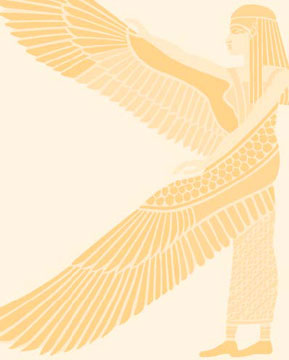
Day 1
Travel
to Cairo. Flight not included. Arrive at Cairo Airport where our
representative will meet and assist you through customs and then
you claim your baggage. You will be transferred to our select
five-star hotel right in the shadow of the Great
Pyramid!
After a rest, shower and food our group will come together to begin our 9th Wave ceremony to anchor the Unity Consciousness in ancient Egypt on the actual day of the beginning of the final wave of the Mayan Calendar. Overnight Hotel.
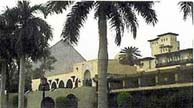
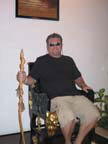  
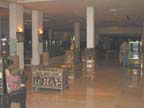 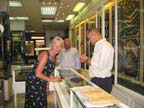 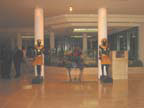
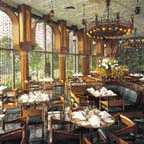 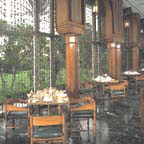
Day 2: CAIRO / ASWAN (B
D)
Today you will be transported back to the time of the ancient Egyptians. Amro Mounier our Egyptologist and spiritual brother will accompany us for our first visit to the awe-inspiring Pyramids and Sphinx on Giza Plateau. One of the seven ancient wonders of the world will inspire you and open you to the miracles that you have created. Then, depending on what pyramid is open this day, we will experience a ceremony in the second Pyramid of Khafre.
After
a quick lunch, its onto Sakkara to see the first pyramid
ever built - the Step Pyramid of Zosser.(Known as the Throat Chakra) Time and energy permitting we will then visit Dashur and experience the famous Red Pyramid with a
short and powerful dessert walk to the Bent Pyramid.
Transfer to Giza Train Station to take your train to Aswan.
Overnight Train (B D)
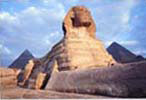  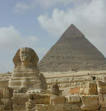
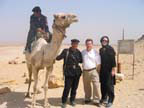 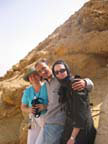 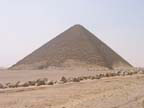
GIZA PLATEAU, SPHINX,
PYRAMIDS, Your first morning in Egypt! We €™ll visit the Giza Plateau and Sphinx... The primary pyramids are (1) Khufu €™s ~ appears smaller than Khafre €™s because it is built on higher ground ~ consists of a subterranean chamber, queen €™s chamber and king €™s chamber which is the object of on going controversy with its monolithic sarcophagus made of pink granite; (2) Khafre ~ near the top are the remaining
original casing stones ~ "burial" chamber is just below ground
level with a plain red granite sarcophagus; (3) Menkaure ~ about half the size of the other two ~ a basalt sarcophagus was found but was lost at sea while being transported to England. Sphinx ~ much has been written and there are innumerable interpretations -- let your heart be your guide! ~ note the Tuthmosis IV €™s dream stela between the paws ~ conservation work has been done to both the Sphinx and the Sphinx temple.
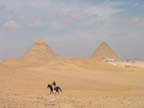 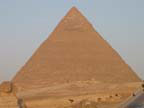 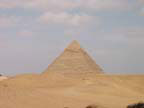
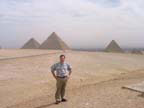 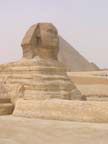 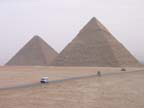
Today we travel through the Egyptian countryside
enjoying the scenery as we travel on to Sakkara ~ the grand step-pyramid complex is magnificent and continues as a source of discoveries. The entire complex consists of the pyramid, entry colonnade, south tomb, south/north pavilion, and mortuary temple and west mounds. The step-pyramid may be the oldest stone bld. in the world. Was created by Imhotep: architect, doctor, sage, astronomer, high priest and visionary. We will have lunch at the Blue Lotus, a charming, family run experience very aptly named. Then onto Memphis ~ old capital of the old kingdom of which little remains but it is noted for its giant statue of Ramses II.
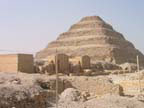 Sakkara is one section of the great
necropolis of Memphis, the Old Kingdom capital and the kings of the
1st Dynasty as well as that of the 2nd Dynasty. are mostly buried
in this section of the Memphis necropolis. It has been of constant
interest to Egyptologists. Sakkara is one section of the great
necropolis of Memphis, the Old Kingdom capital and the kings of the
1st Dynasty as well as that of the 2nd Dynasty. are mostly buried
in this section of the Memphis necropolis. It has been of constant
interest to Egyptologists.
Three major discoveries have recently been made at Sakkara, including a prime minister's tomb, a queen's pyramid, and the tomb of the son of a dynasty-founding king. Each discovery has a fascinating story, with many adventures for the archaeologists as they revealed the secrets of the past.
Sakkara is best known for the Step Pyramid, the oldest known of Egypt's 97 pyramids. It was built for King Djoser of the 3rd Dynasty by the architect and genius Imhotep, who designed it and its surrounding complex to be as grand as it was unique and revolutionary. Imhotep was the first to build stone tombs in honor of the king's majesty. His many titles included 'Treasurer of the King of Lower Egypt', 'Administrator of the Great Palace', and 'Imhotep the Builder, the Sculptor, the Maker of Stone Vessels'. Imhotep may have also designed the pyramid of Djoser's successor, Sekhemkhet.
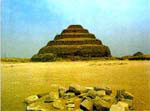 The Step Pyramid of Djoser (Zoser): Across
the Great Court of the Pyramid Complex of Djoser (Zoser) (2667 -
2648 BC), the second king of the 3rd Dynasty, stands the Step
Pyramid, located at Sakkara close to modern day Cairo. It is
believed to have been created by one man, Imhotep. He has been
called Doctor, Sage, Architect, Astronomer and High Priest. During
an excavation in 1924-26, a pedestal of a statue of Djoser (Zoser)
was found. This complex represents the first major work in stone.
That is, unless there are other works that have yet to be
found. The Step Pyramid of Djoser (Zoser): Across
the Great Court of the Pyramid Complex of Djoser (Zoser) (2667 -
2648 BC), the second king of the 3rd Dynasty, stands the Step
Pyramid, located at Sakkara close to modern day Cairo. It is
believed to have been created by one man, Imhotep. He has been
called Doctor, Sage, Architect, Astronomer and High Priest. During
an excavation in 1924-26, a pedestal of a statue of Djoser (Zoser)
was found. This complex represents the first major work in stone.
That is, unless there are other works that have yet to be
found.
On
the Pyramid, most of the outer casing is gone. In some places the
core masonry has disappeared as well. It is obvious there were
different stages of construction. The eastern side gives the best
picture, but it can be seen from the northern and southern side as
well.
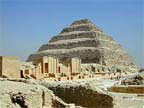 The original structure was an underground burial
chamber. This chamber was rare in that it was square; most mastabas
were rectangular. The royal tomb is 28m underground with a vertical
shaft leading to it. The entrance was sealed with a 3 ton piece of
granite. The face of the mastaba was a fine Tura limestone.
Apparently it was intended for this to be the finishing touches to
the building. It was then enlarged all around with ten feet of
additional limestone and then again with an extension on the
eastern side. The extension was twenty-five feet of limestone to
make the mastaba rectangular. Again, it was enlarged and a
two-tiered structure was made. A series of corridors and a tomb
chamber was dug. Some of the chambers are lined with blue tiles.
Some scholars think this tomb was intended for a member of Djoser's
(Zoser's) family, but not for him. The only other site that has
similar tiling is in the South Tomb which is located in the Djoser
(Zoser) complex as well. The original structure was an underground burial
chamber. This chamber was rare in that it was square; most mastabas
were rectangular. The royal tomb is 28m underground with a vertical
shaft leading to it. The entrance was sealed with a 3 ton piece of
granite. The face of the mastaba was a fine Tura limestone.
Apparently it was intended for this to be the finishing touches to
the building. It was then enlarged all around with ten feet of
additional limestone and then again with an extension on the
eastern side. The extension was twenty-five feet of limestone to
make the mastaba rectangular. Again, it was enlarged and a
two-tiered structure was made. A series of corridors and a tomb
chamber was dug. Some of the chambers are lined with blue tiles.
Some scholars think this tomb was intended for a member of Djoser's
(Zoser's) family, but not for him. The only other site that has
similar tiling is in the South Tomb which is located in the Djoser
(Zoser) complex as well.
After the third stage was finished, the process to
make it a true step pyramid was begun. Over 200,000 tons of stone
was used to make the additional two tiers that went above the
existing two-tiered structure. An additional two tiers were added
above the existing four to make it into the six-tiered pyramid
which is there today. A Tura limestone face was added
on.
On
the northern side of the pyramid, a few blocks of the casing
remain. The casing blocks from the Great Pyramid rested on the
individual blocks of the core masonry. The casing blocks on the
step pyramid were set at an angle to take up the thrust of the
successive layers.
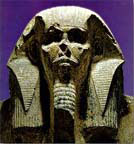 The statue of Djoser (Zoser) that was found by
excavators, was found in the Tomb Chamber. This statue was damaged
but still intact. It is located in the Cairo Museum. The Tomb
Chamber has a replica of the statue in this blue-tiled room. It can
still be seen through the viewing slit that is at the entrance. The
chamber is closed to the public. Scholars believed that the roof of
the chamber could give way. The chamber walls have inscriptions
that show beyond any doubt that this is indeed a burial chamber. It
also contains offering rooms and most of the other features that
were often found in both earlier and later
tombs. The statue of Djoser (Zoser) that was found by
excavators, was found in the Tomb Chamber. This statue was damaged
but still intact. It is located in the Cairo Museum. The Tomb
Chamber has a replica of the statue in this blue-tiled room. It can
still be seen through the viewing slit that is at the entrance. The
chamber is closed to the public. Scholars believed that the roof of
the chamber could give way. The chamber walls have inscriptions
that show beyond any doubt that this is indeed a burial chamber. It
also contains offering rooms and most of the other features that
were often found in both earlier and later
tombs.
The
Mortuary Temple is just north of the pyramid and is in total ruin.
On the southern wall back across the Great Court from the pyramid
are carved cobra heads or uraei. The cobra head is an often seen
symbol in Egypt. It was once a symbol of the
north.
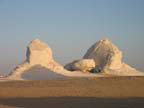 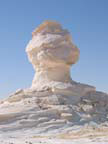 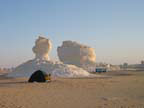
The
Southern Tomb is located just outside of the southern wall. Steps
lead up the wall to the other tombs and monuments outside the
walls. On the left side of the stairs, there is a large hole. At
the bottom of the hole, is an entrance that leads to an amazing set
of chambers. This Southern Tomb is closed to the public. These
chambers are also lined with the blue tiles that arefound in the
burial chambers in the Step Pyramid. The inscriptions found in
these chambers are remarkable. They are perfectly executed and pure
in line.
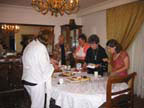 
Day 3: ASWAN
(B)
Awaken
in beautiful Aswan where you will feel the change in tempo and
energy as you enjoy the hospitality of the gracious dark skinned
Nubian people. We will be met and transferred to a beautiful
five-star hotel on the powerful and ancient Nile River. After check
in and a refreshing shower it is off on a boat ride to the Island
oh Philae where we will honor the divine mother Isis
at the temple dedicated to her. When we return to the hotel we may
choose a late afternoon experience at Elephantine Island for
a chance to rest and enjoy the pool and the Nile View. Overnight
hotel (B)
Continue our sail on to the magical city of Aswan,
home to the beautiful and gracious Nubian people. After lunch and
docking, we will take a ferry to Isis Temple -- a breathtaking temple located on the Island of Philae -- saved from high dam flooding the buildings were completely moved between 1972-80 Hathor was also honored here (just as Isis is at Dendara) -- the worship of Isis continued long after the intro of Christianity -- about 570 AD a Catholic church was established on the site.
Philae in Greek or Pilak in ancient
Egyptian, meaning 'the end,' defined the southern most limit of
Egypt. It was begun by Ptolemy II and completed by the Roman
Emperors. The Temple was dedicated to the goddess Isis, the wife of
Osiris and mother of Horus. These three characters dominate ancient
Egyptian culture and their story possesses all the drama of a
Shakespearian tragedy. The god Osiris is murdered and dismembered
by his brother Seth. Isis searches for the fragments, collects them
together and with her magic powers brings Osiris back to life. They
then conceive the god Horus. Osiris becomes god of the under world
and judge of the dead - who must answer to him for their deeds on
Earth. Meanwhile Isis gives birth to Horus and protects the young
god. Later when Horus is grown he avenges his father by defeating
Seth in
combat.
Elephantine Island
is the largest of the Aswan area islands, and is one of the most
ancient sites in Egypt, with artifacts dating to predynastic
periods.
  
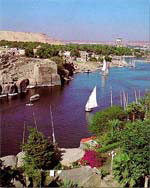 Elephantine is Greek for elephant. In ancient
times, the Island, as well as the southern town, was called Abu, or
Yabu, which also meant elephant. The town has also been referenced
as Kom, after its principle god of the island, Khnum (Khnemu). It
is believed that the island received its name because it was a
major ivory trading center, though in fact, it was a major trading
post of many commodities. There are large boulders in the river
near the island which resembled bathing elephants, particularly
from afar, and this too has been suggested as a reason for the
island's
name. Elephantine is Greek for elephant. In ancient
times, the Island, as well as the southern town, was called Abu, or
Yabu, which also meant elephant. The town has also been referenced
as Kom, after its principle god of the island, Khnum (Khnemu). It
is believed that the island received its name because it was a
major ivory trading center, though in fact, it was a major trading
post of many commodities. There are large boulders in the river
near the island which resembled bathing elephants, particularly
from afar, and this too has been suggested as a reason for the
island's
name.
The island is very
beautiful, and while many of the artifacts there are in ruin, there
is still considerable to see. There has been an ongoing excavation
at the town for many years by the German Archaeological Institute,
and some of the finds along with many other island artifacts,
including a mummified ram of Khnum, are located in the Elephantine
Museum.
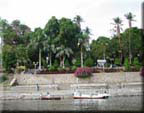 Another major attraction is the ruins of the Temple
of Khnum. Elephantine Island was considered to be home of this
important Egyptian god, and while this structure dates back to the
Queen Hatshepsut of the 18th Dynasty, there are references to a
Temple of Khnum on the island as early as the 3rd
Dynasty. Another major attraction is the ruins of the Temple
of Khnum. Elephantine Island was considered to be home of this
important Egyptian god, and while this structure dates back to the
Queen Hatshepsut of the 18th Dynasty, there are references to a
Temple of Khnum on the island as early as the 3rd
Dynasty.
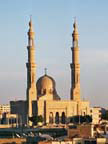 There are also ruins of a Temple of Satet, who was
Khnum's female counterpart (the three local deities were foremost
Khnum, but also Satet and a local Nubian goddess Anqet. These gods
were worshipped here since the earliest dynasties), also built by
Queen Hatshepsut, a shrine to Hekayib from the 6th Dynasty, a local
governor who was deified after his death. His cult flourished
during the middle kingdom, and some fine statues from the shrine
are now in the museum. You will also find a 3rd Dynasty granite
step pyramid which is now just visible, and to the north, the
mud-brick vaults of the late period which housed the bodies of the
royal rams. On the south end of the island is a small one room
Ptolemaic temple which was constructed from materials removed from
the Kalabsha Temple. Here, there are decorations attributed to the
Nubian Pharaoh Arkamani from the 3rd century BC The building seems
to have been finished by the Romans with reference to Caesar
Augustus. There are also ruins of a Temple of Satet, who was
Khnum's female counterpart (the three local deities were foremost
Khnum, but also Satet and a local Nubian goddess Anqet. These gods
were worshipped here since the earliest dynasties), also built by
Queen Hatshepsut, a shrine to Hekayib from the 6th Dynasty, a local
governor who was deified after his death. His cult flourished
during the middle kingdom, and some fine statues from the shrine
are now in the museum. You will also find a 3rd Dynasty granite
step pyramid which is now just visible, and to the north, the
mud-brick vaults of the late period which housed the bodies of the
royal rams. On the south end of the island is a small one room
Ptolemaic temple which was constructed from materials removed from
the Kalabsha Temple. Here, there are decorations attributed to the
Nubian Pharaoh Arkamani from the 3rd century BC The building seems
to have been finished by the Romans with reference to Caesar
Augustus.
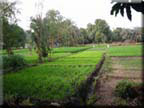 Elephantine Island is a beautiful place to visit,
with wonderful gardens and some truly significant artifacts. It is
also a good place to spend some leisure time, wondering among the
Nubian villages where the people are friendly and the houses are
often very colorful. The houses often have paintings or carved with
a crocodile at the bottom, a fish in the middle and a man on top,
with a woman's hand made of brass as a door knocker between the
fish and man. Others will have a sacred black cube of Mecca, with a
painting depicting the means of the owner's pilgrimage to
Mecca. Elephantine Island is a beautiful place to visit,
with wonderful gardens and some truly significant artifacts. It is
also a good place to spend some leisure time, wondering among the
Nubian villages where the people are friendly and the houses are
often very colorful. The houses often have paintings or carved with
a crocodile at the bottom, a fish in the middle and a man on top,
with a woman's hand made of brass as a door knocker between the
fish and man. Others will have a sacred black cube of Mecca, with a
painting depicting the means of the owner's pilgrimage to
Mecca.
 Agha-Khan is the Mausoleum of the spiritual
leader of the Ismailis, a Shi'ite sect (as were the Fatimid) based
principally in India but with followers around the world. It is a
very elegant pink granite structure of late 1950 origin, which also
resembles the Fatimid tombs in Cairo. Members of this sect consider
themselves to be the direct spiritual descendants of the Fatimid.
The Mausoleum has an excellent view, including Aga Khan's white
villa below, and is near the Monastery of St. Simeons on the west
bank at Aswan. His Begun, or wife, still lives in the villa three
months of the
year. Agha-Khan is the Mausoleum of the spiritual
leader of the Ismailis, a Shi'ite sect (as were the Fatimid) based
principally in India but with followers around the world. It is a
very elegant pink granite structure of late 1950 origin, which also
resembles the Fatimid tombs in Cairo. Members of this sect consider
themselves to be the direct spiritual descendants of the Fatimid.
The Mausoleum has an excellent view, including Aga Khan's white
villa below, and is near the Monastery of St. Simeons on the west
bank at Aswan. His Begun, or wife, still lives in the villa three
months of the
year.
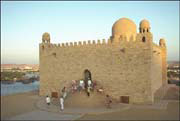 The Aga Khan was extremely wealthy. On his birthday
in 1945, he was weighed in diamonds which he then distributed to
his followers. It should be noted, also, that he was a large man.
Every day that his widow was at the Villa, she places a Red Rose on
his white Carrara marble tomb. His widow, Omme Habibeh, popularly
referred to as "The Begum" died on July 1st, 2000. The other
months, a gardener fills this function, and it has been rumored
that at one point, not a single rose could be found in Egypt, so
for almost a week, roses were flown in from Paris by private
jet. The Aga Khan was extremely wealthy. On his birthday
in 1945, he was weighed in diamonds which he then distributed to
his followers. It should be noted, also, that he was a large man.
Every day that his widow was at the Villa, she places a Red Rose on
his white Carrara marble tomb. His widow, Omme Habibeh, popularly
referred to as "The Begum" died on July 1st, 2000. The other
months, a gardener fills this function, and it has been rumored
that at one point, not a single rose could be found in Egypt, so
for almost a week, roses were flown in from Paris by private
jet.
Mohammed Shah Aga Khan was
educated in Europe and succeeded his father in 1885 to become the
48th imam. He was succeeded by his grandson, Karim AGa Khan upon
his death in
1957.
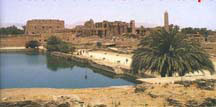
Day 4: ASWAN /
LUXOR
Early
morning drive to Luxor stopping at Edfu the Temple of Horus
and the most powerful temple of transformation in all of Egypt.
Then back on our comfortable, air conditioned bus with the next
stop at the inspiring Temple of Kom Ombo where we honor the
integration of both the dark and the light dedicated to Horus
the Hawk (light) and Sobek the alligator (dark), for an
important ceremony of integration. We finish the day at another
wonderful five-star hotel on the Nile for rest and relaxation and
group sharing. Overnight Hotel (B)
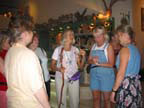 
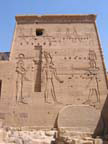 Between Aswan and Luxor is located the major
Ptolemaic temple of Edfu - the best preserved
major temple in Egypt. The temple is dedicated to the falcon god
Horus and was built over a 180-year period from 237 BC to 57 BC.
Inside the temple's pylons is a large courtyard. Just before the
entrance to the first of two hypostyle halls is a welcoming statue
of Horus. Inside the hypostyle halls are dominated by a forest of
towering
columns. Between Aswan and Luxor is located the major
Ptolemaic temple of Edfu - the best preserved
major temple in Egypt. The temple is dedicated to the falcon god
Horus and was built over a 180-year period from 237 BC to 57 BC.
Inside the temple's pylons is a large courtyard. Just before the
entrance to the first of two hypostyle halls is a welcoming statue
of Horus. Inside the hypostyle halls are dominated by a forest of
towering
columns.
Dedicated to Horus, the falcon headed god, it was
built during the reigns of six Ptolemies. We have a great deal of
information about its construction from reliefs on outer areas. It
was begun in 237 BC by Ptolemy III Euergetes I and was finished in
57 BC. Most of the work continued throughout this period with a
brief interlude of 20 years while there was unrest during the 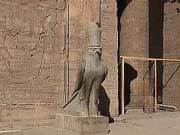 period of
Ptolemy IV and Ptolemy V
Epiphanes. period of
Ptolemy IV and Ptolemy V
Epiphanes.
This
is not only the best preserved ancient temple in Egypt, but the
second largest after Karnack. It was believed that the temple was
built on the site of the great battle between Horus and Seth.
Hence, the current temple was but the last in a long series of
temples build on this location. It is said that the original
structure housing a statue of Horus was a grass hut built in
prehistoric times. At any rate, there is an earlier and smaller
pylon of Ramesses II which sits in a 90 degree angle to the current
building.
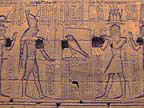 The main
building, which includes a great Hypostyle Hall, was uncovered by
Mariette in the 1860s. There are numerous reliefs, including a
depiction of the Feast of the Beautiful Meeting, the annual reunion
between Horus and his wife Hathor. The reliefs are mostly situated
on the inside of the first pylon, and spiritually connect this
temple with Hathor's Temple at the Dendera complex. During the
third month of summer, the priests at the Dendera complex would
place the statue of Hathor on her barque (a ceremonial barge) and
would thus bring the statue to the Edfu Temple, where it was
believed that Horus and Hathor shared a conjugal visit. Each night,
the god and goddess would retire to the mamissi, or berthing
house. The main
building, which includes a great Hypostyle Hall, was uncovered by
Mariette in the 1860s. There are numerous reliefs, including a
depiction of the Feast of the Beautiful Meeting, the annual reunion
between Horus and his wife Hathor. The reliefs are mostly situated
on the inside of the first pylon, and spiritually connect this
temple with Hathor's Temple at the Dendera complex. During the
third month of summer, the priests at the Dendera complex would
place the statue of Hathor on her barque (a ceremonial barge) and
would thus bring the statue to the Edfu Temple, where it was
believed that Horus and Hathor shared a conjugal visit. Each night,
the god and goddess would retire to the mamissi, or berthing
house.
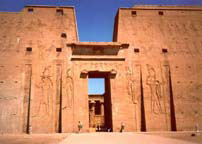 There is still an entrance colonnade to the
mamissi, and reliefs with considerable remaining color just outside
the main temple. These images portray the ritual of the birth of
Harsomtus, son of Horus and
Hathor. There is still an entrance colonnade to the
mamissi, and reliefs with considerable remaining color just outside
the main temple. These images portray the ritual of the birth of
Harsomtus, son of Horus and
Hathor.
The
pylons of the main Temple are about 118 feet high with typical
scenes of the pharaoh in battle with his enemies. Within the pylons
is the colonnaded courtyard with distinctive, pared columns, which
leads into the great hypostyle hall. But on either side of the
courtyard there are gates which lead to an area behind the temple
and inside the bounding walls. Here, there are inscriptions
recording donations of land which were probably transferred from
demotic documents. There are also dramatic images depicting the
defeat of Seth by Horus. There was an annual ritual called the
known as the Triumph of Horus (10 harpoons) which ended in the
slaying of a hippopotamus, the symbol of
Seth.
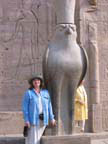 The facade of the first hypostyle hall has images
honoring Horus and Hathor, and there is an immaculate ten foot tall
colossi of Horus as the falcon god here (a matching colossi was
destroyed). As you enter the great hall, you will begin to notice
the use of light. Even though the temple was built over hundreds of
years, it is very harmonious, and ebbs and flow of lighting was
certainly purposeful, portraying a feeling of mystery. Just inside
the hall are two small rooms, a robing room on the west and a
library to the east where the priest would obtain the religious
orders of the day. Within this hall are scenes of offering
including the temple foundation
ceremonies. The facade of the first hypostyle hall has images
honoring Horus and Hathor, and there is an immaculate ten foot tall
colossi of Horus as the falcon god here (a matching colossi was
destroyed). As you enter the great hall, you will begin to notice
the use of light. Even though the temple was built over hundreds of
years, it is very harmonious, and ebbs and flow of lighting was
certainly purposeful, portraying a feeling of mystery. Just inside
the hall are two small rooms, a robing room on the west and a
library to the east where the priest would obtain the religious
orders of the day. Within this hall are scenes of offering
including the temple foundation
ceremonies.
 Beyond the
great hypostyle hall is a second, smaller hypostyle hall which
leads to a well called the Chamber of the Nile where the Priests
obtained pure holy water. This is a similar arrangement as found at
Dendera. On the west side of the room are doors that lead to a
small laboratory with recipes engraved on the walls for ointments
and perfumes which where used daily to anoint the statue of Horus,
and to a treasure room where offerings were
stored. Beyond the
great hypostyle hall is a second, smaller hypostyle hall which
leads to a well called the Chamber of the Nile where the Priests
obtained pure holy water. This is a similar arrangement as found at
Dendera. On the west side of the room are doors that lead to a
small laboratory with recipes engraved on the walls for ointments
and perfumes which where used daily to anoint the statue of Horus,
and to a treasure room where offerings were
stored.
Beyond the second hypostyle hall is the offering
hall, followed by the vestibule and finally the sanctuary. There is
a granite naos here dedicated by Nectanebo II, making it the oldest
relic in the temple. It is probable that a golden gilded wooden
statue of Horus about 60 cm tall would have resided on the naos.
This statue would have been cared for by the priests in a human
manner, being washed, dressed, anointed, fed and
entertained.
 The
sanctuary itself is surrounded by chapels and rooms which, when
facing north and in clockwise order, are the chapel of Min, the
chamber of linen where the robs of the Horus would have been
stored, the chamber of the throne of gods, the chamber of Osiris,
the chamber of the West, the tomb of Osiris, the chamber of the
victor (Horus), where there is a reconstructed ceremonial barge
(barque), chapels of Khonsu and Hathor, the chapel of the throne of
Ra and a chapel of the spread wings, dedicated principally to
Mehit, the lioness who guarded the path the soul passed on its
journey towards resurrection. The front chapel on the east is the
Chapel of the New Year, a sun court like that at Dendera. Here, a
depiction on the ceiling show the voyage of the solar barque
through the Twelve Hours of the day, with an inspiring image of the
goddess, Nut. The statue of Horus would be taken from here up a
flight of stairs to the roof terrace where it would be recharged by
the sun during the Festival of the New Year. The walls of the
stairs located in the outer anti-chamber depict this
ritual. The
sanctuary itself is surrounded by chapels and rooms which, when
facing north and in clockwise order, are the chapel of Min, the
chamber of linen where the robs of the Horus would have been
stored, the chamber of the throne of gods, the chamber of Osiris,
the chamber of the West, the tomb of Osiris, the chamber of the
victor (Horus), where there is a reconstructed ceremonial barge
(barque), chapels of Khonsu and Hathor, the chapel of the throne of
Ra and a chapel of the spread wings, dedicated principally to
Mehit, the lioness who guarded the path the soul passed on its
journey towards resurrection. The front chapel on the east is the
Chapel of the New Year, a sun court like that at Dendera. Here, a
depiction on the ceiling show the voyage of the solar barque
through the Twelve Hours of the day, with an inspiring image of the
goddess, Nut. The statue of Horus would be taken from here up a
flight of stairs to the roof terrace where it would be recharged by
the sun during the Festival of the New Year. The walls of the
stairs located in the outer anti-chamber depict this
ritual.
Day 5
Today you will
start your tour on the East Bank of Luxor. Entering down the
ancient Avenue of the Ram Headed Sphinx, we arrive at the
Monumental Temple of Karnack (Healing of the Ego and Birth
of the Heart). After ceremony and contemplation as well as a visit
to the Temple of Sekmet (Lion Goddess) within the Karnack
Complex, it is on to the famous Luxor Temple (The Temple of
Man). This Temple was built to simulate the human body and it is
here we will be anchoring the field "Unity Conscious" as we walk in
silence activating our physical cells to anchor the 9th
wave in our physical bodies(a resurrection ceremony). After a
powerful day, a free evening to enjoy this vibrant and fascinating
city of Luxor for dining and shopping. Overnight Hotel
(B)
We
will travel down the Avenue of the Rams to reach the Temple of
Karnack. This temple boasts many multiple temples, obelisks,
great gates and the famous hypostyle hall. We will also come
face-to-face with the lion goddess Sehkmet. Karnack is the largest
temple complex in Egypt and demonstrates the religious significance
of the area in ancient times.
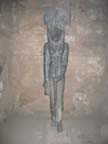 Luxor Temple: A strip of green in the middle of the desert tilled fields and in the background the red rocks of the "Libyan Chain" Here lies Luxor, one of the greatest capitals of the ancient world. Luxor Temple: A strip of green in the middle of the desert tilled fields and in the background the red rocks of the "Libyan Chain" Here lies Luxor, one of the greatest capitals of the ancient world.
Charming and evocative, with the Nile along the quiet waters of the river, the small, silent streets of the Bazaar that come to life in the evening with their colours, sounds and lights.
 In ancient Egypt, the power of the god Amun of Thebes gradually increased during the early New Kingdom, and after the short persecution led by Akhenaten, it rose to its apex. In the reign of Ramesses III, more than two thirds of the property owned by the temples belonged to Amun, evidenced by the stupendous buildings at Karnack. Although badly ruined, no site in Egypt is more impressive than Karnack. It is the largest temple complex ever built by man, and represents the combined achievement of many generations of ancient builders. The Temple of Karnack is actually three main temples, smaller enclosed temples, and several outer temples located about three kilometers north of Luxor, Egypt situated on 100 ha (247 acres) of land. Karnack is actually the sites modern name. Its ancient name was Ipet-isut, meaning "The Most Select (or Sacred) of Places". In ancient Egypt, the power of the god Amun of Thebes gradually increased during the early New Kingdom, and after the short persecution led by Akhenaten, it rose to its apex. In the reign of Ramesses III, more than two thirds of the property owned by the temples belonged to Amun, evidenced by the stupendous buildings at Karnack. Although badly ruined, no site in Egypt is more impressive than Karnack. It is the largest temple complex ever built by man, and represents the combined achievement of many generations of ancient builders. The Temple of Karnack is actually three main temples, smaller enclosed temples, and several outer temples located about three kilometers north of Luxor, Egypt situated on 100 ha (247 acres) of land. Karnack is actually the sites modern name. Its ancient name was Ipet-isut, meaning "The Most Select (or Sacred) of Places".
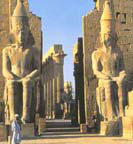 This is the great, ancient city of Thebes, capital
of the Egyptian empire for almost one thousand years, which Homer
referred to in the IX canto of the Iliad as "Thebes with one
hundred gates" and for which "only the grains of sand in the desert
surpassed the abundance of wealth contained therein". The Copts
called it Tapé, hence the Greek Thebai, but for Egyptian
inhabitants it was Uaset, meaning "the chief town" and Niut, "the
City" it was later on called Diospolis Magna. Its present name of
Luxor comes from the Arab El Qousour, translation of the Latin
"Castra" with which the ancient Romans indicated the city where
they had installed two
encampments. This is the great, ancient city of Thebes, capital
of the Egyptian empire for almost one thousand years, which Homer
referred to in the IX canto of the Iliad as "Thebes with one
hundred gates" and for which "only the grains of sand in the desert
surpassed the abundance of wealth contained therein". The Copts
called it Tapé, hence the Greek Thebai, but for Egyptian
inhabitants it was Uaset, meaning "the chief town" and Niut, "the
City" it was later on called Diospolis Magna. Its present name of
Luxor comes from the Arab El Qousour, translation of the Latin
"Castra" with which the ancient Romans indicated the city where
they had installed two
encampments.
 In the Memphis era it was a small village where the God of War Montu was worshipped and its temples marked the boundaries of the territory. As from the X Dynasty, thanks to its geographical position and political grounds, its importance started to increase considerably until the military successes of its princes made it a great power. Capital of the pharaohs of the New Empire, the god Amon was worshipped in great splendour in the triad in Mut and Khnsu. It was the age of great victories and triumph in Asia Minor, Nubia and Libya. It was a happy period perhaps the happiest in Egyptian history and Thebes had no rivals : victorious Pharaohs accumulated incredible wealth there (city where the houses are rich in treasure) from war booty; from the Red Sea the Persian Gulf and even from the Sahara across the road of the oases merchants arrived to grow rich and to enrich the
townsmen of Thebes who reached the incredible figure of half a
million! In the Memphis era it was a small village where the God of War Montu was worshipped and its temples marked the boundaries of the territory. As from the X Dynasty, thanks to its geographical position and political grounds, its importance started to increase considerably until the military successes of its princes made it a great power. Capital of the pharaohs of the New Empire, the god Amon was worshipped in great splendour in the triad in Mut and Khnsu. It was the age of great victories and triumph in Asia Minor, Nubia and Libya. It was a happy period perhaps the happiest in Egyptian history and Thebes had no rivals : victorious Pharaohs accumulated incredible wealth there (city where the houses are rich in treasure) from war booty; from the Red Sea the Persian Gulf and even from the Sahara across the road of the oases merchants arrived to grow rich and to enrich the
townsmen of Thebes who reached the incredible figure of half a
million!
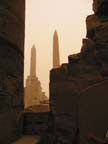 One the east bank rise the temples in which the gods
dwelt whereas on the west bank building were constructed for the
worship of dead sovereigns; apart from this theory of temples,
parallel to the river runs the heavy rock curtain that conceals the
Valley of the Kings. One the east bank rise the temples in which the gods
dwelt whereas on the west bank building were constructed for the
worship of dead sovereigns; apart from this theory of temples,
parallel to the river runs the heavy rock curtain that conceals the
Valley of the Kings.
Thebes then inexorably fell. The
very geographical position that one thousand years beforehand had
favored the birth of its power now became the main reason for its
decline : too far from the "hot" delta region, where the Ramses
were forced to create military stations to stem foreign invasions,
Thebes lost its political, spiritual and military supermacy.
Subsequent dynasties originally came from the delta and the twons
of tains, Bubast and Sais replaced it as capital of Egypt. Left
defenseless.
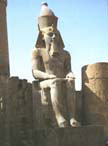 Thebes fell prey to the Assyrian army lead by
Assarhaddon, which sacked it in 672 B.C.; once again in 665,
Assurbanipal's army deported the townsmen before turning them into
slaves and stripped the town of its statues and treasures. Lastly,
it was completely razed to the ground in 84 B.C. by Ptolemy
Lathyros to the extent that during the roman era it was a mass of
ruins visited by wayfarers; the few remaining townsmen settled in
what remained of the temples and the tombs were reduced to stables.
This time too, as happened in the case of Memphis, Ezekiel's
prophecy that Thebes would be violently shaken came
true. Thebes fell prey to the Assyrian army lead by
Assarhaddon, which sacked it in 672 B.C.; once again in 665,
Assurbanipal's army deported the townsmen before turning them into
slaves and stripped the town of its statues and treasures. Lastly,
it was completely razed to the ground in 84 B.C. by Ptolemy
Lathyros to the extent that during the roman era it was a mass of
ruins visited by wayfarers; the few remaining townsmen settled in
what remained of the temples and the tombs were reduced to stables.
This time too, as happened in the case of Memphis, Ezekiel's
prophecy that Thebes would be violently shaken came
true.
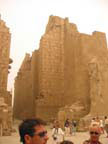 Temple of Amon Ra: In Luxor, all that remains of its glorious past is the temple that the ancient Egyptians built to the glory of Amon ra king of the gods, and which they called "Southern harem of Amon". Temple of Amon Ra: In Luxor, all that remains of its glorious past is the temple that the ancient Egyptians built to the glory of Amon ra king of the gods, and which they called "Southern harem of Amon".
Brought back to light in 1883 by Gaston Maspéro, the temple is 260 metres long and its construction was basically commissioned by two Pharaohs, Amon-Ofis III who started it in the XIV century B.C. and Ramses II who completed it adding the porticoed courtyard with its axis moved eastwards, and no longer north-south as in the case of the rest of the temples.
The architect was probably amenophis, son of Hotep. The temple of Luxor was joined to that of Karnack by a long stone-paved dromos, a drome and a processional avenue, flanked by sphinxes with rams heads that the XXX Dynasty replaced with sphynexes with human heads. This street has not been brought to life completely and they are still working on it.
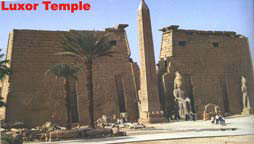 The avenue ended at the entrance to the temple of Luxor, marked by the large pylon erected by Ramses II, which features a 65-metre front decorated with bas-reliefs illustrating scenes of the military campaigns of the Pharaoh against the Hittites. The avenue ended at the entrance to the temple of Luxor, marked by the large pylon erected by Ramses II, which features a 65-metre front decorated with bas-reliefs illustrating scenes of the military campaigns of the Pharaoh against the Hittites.
In ancient time, the pylon was
preceded by two obelisks, two seated colossi and two standing
colossi. Today, only the left 25-metre high obelisk is still
standing: the other was taken to Paris in 1833 and placed by the
engineer Lebas in Place de la Concorde on the 25th October 1836.
The two colossi in granite represent the Pharaoh seated on his
throne, fifteen and a half 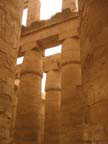 metres in height on a base of about one metre. Of the other four statues in pink granite leaning against the pylon, one was to represent Queen Nefertari and another decrepit one to the right, his daughter Merit-Amon. metres in height on a base of about one metre. Of the other four statues in pink granite leaning against the pylon, one was to represent Queen Nefertari and another decrepit one to the right, his daughter Merit-Amon.
Having passed through the triumphal entrance, one enters the court of Ramses II, with its double row of columns with closed papyrus capital and statues of Osiris in the inter columns. To the north-west of the courtyard one can admire the temple-deposit of the sacred boats built by Thot-Mosis III and dedicated to the triad Amon, Mut and Khonsu.
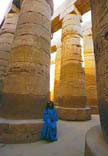 Then follows a colonnade of two rows of bell-shaped
columns 52 meters long that take us to the second courtyard, or
courtyard of Amon-Ofis II, surrounded on three sides by two rows of
columns with closed papyruses, a real, highly evocative forest.
From here, across a transversal hypostyle hall, one enters the last
sanctuary, the most intimate and sacred part, which gave the temple
its name of "Adytum of the south" theatre o the final moment of the
festival of Opet, the largest and most solemn held during the
year. Then follows a colonnade of two rows of bell-shaped
columns 52 meters long that take us to the second courtyard, or
courtyard of Amon-Ofis II, surrounded on three sides by two rows of
columns with closed papyruses, a real, highly evocative forest.
From here, across a transversal hypostyle hall, one enters the last
sanctuary, the most intimate and sacred part, which gave the temple
its name of "Adytum of the south" theatre o the final moment of the
festival of Opet, the largest and most solemn held during the
year.
The festival, which lasted little
more than fifteen days, started on the nineteenth day of the second
month of the flood, that is towards the end of August. The
highlight of the ceremony came when out of the temple of Karnack
came the sacred boat of Amon-Ra which carried by thirty priests and
followed by those of Mut and Khonsu, covered the whole avenue of
sphinxes and arrived at the temple of Luxor; here the boats were
closed in the sanctuary for a couple of days, before returning to
the temple of Karnack, always accompanied by a rejoicing crowd
singing and dancing.
Luxor--The Temples of
Thebes
Many of the main roads which lead to
the temples of Thebes (Luxor) used to be continuously lined with
sphinxes. Those which flank the entrance of the First Pylon of
Karnack combine the body of a lion with the head of a ram. The ram
was a symbol of the god Amun for whom the temple was built. Each
sphinx protects, between its forelegs, a standing statue of the
king--originally Ramesses II (c.1279-1213
B.C.).
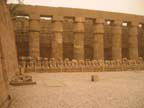 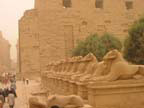
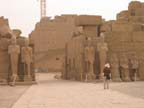 The Temple of Amun at
Karnack The Temple of Amun at
Karnack
Standing in the shadow of the First
Pylon of the Temple of Amun at Karnack (in Luxor, Egypt), one is
struck by the length of its east-west axis and the colossal size of
its columns. Like all other temples in Egypt, this one symbolizes
the mound of the original creation. The ground rises ever so
gradually from the entrance toward the sanctuary. The columns are
stone replicas of the vegetation which was growing in the the
marshy land around the mound of
creation.
In the center of this first court are the ruins of the kiosk of Taharqa (690-664 B.C.), one column (middle ground, right) of which is complete. Beyond the kiosk before the Second Pylon are two standing statues of Ramesses II (c.1279-1213 B.C.). After the Second Pylon, the columns of the Great Hypostyle Hall can be seen.
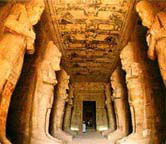 The Great Hypostyle Hall of
Karnack The Great Hypostyle Hall of
Karnack
The Great Hypostyle Hall of Karnack
Temple was begun during the reign of King Sety I (c.1290-1279 B.C.)
and was completed by his son, Ramesses II (c.1279-1213 B.C.). The
north- south axis of the hall provides views which reveal not only
the immensity but also the practicality of the architecture. The
central row of 12 columns on the east-west axis are 69 feet/21
meters in height, about 33 feet/10 meters in circumference, and
have open papyrus capitals. The 122 columns in the side aisles are
43 feet/13 meters in height, 27.5 feet/8.4 meters in circumference,
and have closed papyrus-bud capitals (as seen here). Remember that
the whole of this hall was roofed with stone slabs, and the
interior was quite dark. The difference in height between the
central and the side aisle columns was used to provide natural
light through clerestory windows which have vertical stone
slats.
 Obelisk of
Hatshepsut Obelisk of
Hatshepsut
Leaving the hypostyle hall through
the third pylon you come to a narrow court where there once stood
several obelisks. One of the obelisks was erected by Tuthmosis I
(1504 - 1492 BC) who was the father of Hatshepsut. This obelisk
stands 70 feet (21.3m) tall and weighs about 143 tons. During the
centuries between Tuthmosis I and Ramesses VI, the kings of the
time did more than their share of destroying and dismantling. This
obelisk was never touched. The original inscription was left in its
place. However, two kings did add their inscription on either side
of the original. Beyond this obelisk is the only remaining
Obelisk of Hatshepsut (1473-1458 BC). It is 97 feet (29.6m) high and weighs approximately 320 tons. Besides the Lateran obelisk in Rome, this is the tallest standing obelisk. The one in Rome is 101 feet (30.7m) high. Hatshepsut was a woman who dared to challenge the tradition of male kingship. She died from undisclosed causes after imposing her will for a time. After her death, her name and memory suffered attempted systematic obliteration. The inscription on the obelisk says, "O ye people who see this monument in years to come and speak of that which I have made, beware lest you say, 'I know not why it was done'. I did it because I wished to make a gift for my father Amun, and to gild them with electrum."
The Obelisk of Thutmose
I
Beyond the Third Pylon and in the
Central Court of Karnack Temple is the Obelisk of Thutmose I
(c.1493-1479 B.C.). This is the last of four obelisks which
originally stood in front of the Fourth 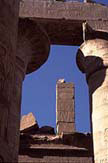 Pylon, which, in the time of Thutmose I, was the
entrance into Karnack Temple. The obelisk is 71 feet/21.7 meters in
height, sits on a base 6 feet/1.8 meters square, and weighs about
143 tons. Each side of the obelisk has three vertical lines of
inscription, the central one being a dedication by Thutmose
I. Pylon, which, in the time of Thutmose I, was the
entrance into Karnack Temple. The obelisk is 71 feet/21.7 meters in
height, sits on a base 6 feet/1.8 meters square, and weighs about
143 tons. Each side of the obelisk has three vertical lines of
inscription, the central one being a dedication by Thutmose
I.
The Sixth Pylon of Karnack
Temple
Just to the east of the Sixth Pylon
of Karnack Temple is the vestibule to the sanctuary (right), where
the priests kept the portable shrine used by the god's statue in
processions. In the vestibule, built by Thutmose III (c.1479-1425
B.C.), are these two granite columns, elegant reminders of the
importance of the concept of a unified Upper (Nile valley) and
Lower (Nile delta) Egypt. These columns are decorated in raised
relief with the papyrus on the left (north/the delta) and the lotus
on the right (south/the
valley).
Day 6: LUXOR / CAIRO
An early morning
start takes us across the Nile to the West Bank where we
will visit Dier Al-Bahari, The Temple of Hatshepsut (The
only female pharaoh). Here we honor the Goddess Hathor (the
nurturer) and the God Anubis (Guide through the Underworld) to
capture their magic and again anchor the "Unity Conscious" energy
in a place where there has been much past pain. A quick lunch and
then onto the Temple of Medinet Habu dedicated to the fierce
warrior Ramses II. At Habu we will create a West Bank ceremony
honoring the warrior within our Unity Consciousness. Then it's back
across the Nile as we head to the Airport for our return flight to
Cairo. Overnight Hotel (B)
Dier Al-Bahari, The Temple of
Hatshepsut ~ The female pharaoh ruled Egypt for 20 years
(18th Dynasty) - this spectacular temple is partially free-standing and partially rock-cut. All three terraces are open and reconstruction is still continuing. There are two small chapels -- on the south dedicated to the goddess Hathor and the other dedicated to Anubis. Medinet
Habu -- the mortuary temple of Ramses III (1184-1153BC). An unusual feature is the entrance to the temple which was constructed in the form of a Syrian fortress -- the temple became a place of security during unsettled times. The painted carved reliefs are particularly well preserved.
 Queen Hatshepsut
Temple Queen Hatshepsut
Temple
The mortuary temple of Queen Hatshepsut
is o ne of the most
dramatically situated in the world. The queen's architect,
Senenmut, designed it and set it at the head of a valley
overshadowed by the Peak of the Thebes, the "Lover of Silence,"
where lived the goddess who presided over the necropolis. A tree
lined avenue of sphinxes led up to the temple, and ramps led from
terrace to terrace. The porticoes on the lowest terrace are out of
proportion and coloring with the rest of the building. They were
restored in 1906 to protect the celebrated reliefs depicting the
transport of obelisks by barge to Karnack and the miraculous birth
of Queen Hatshepsut. Reliefs on the south side of the middle
terrace show the queen's expedition by way of the Red Sea to Punt,
the land of incense. ne of the most
dramatically situated in the world. The queen's architect,
Senenmut, designed it and set it at the head of a valley
overshadowed by the Peak of the Thebes, the "Lover of Silence,"
where lived the goddess who presided over the necropolis. A tree
lined avenue of sphinxes led up to the temple, and ramps led from
terrace to terrace. The porticoes on the lowest terrace are out of
proportion and coloring with the rest of the building. They were
restored in 1906 to protect the celebrated reliefs depicting the
transport of obelisks by barge to Karnack and the miraculous birth
of Queen Hatshepsut. Reliefs on the south side of the middle
terrace show the queen's expedition by way of the Red Sea to Punt,
the land of incense.
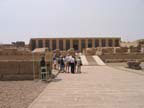 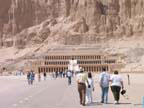 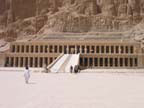
Along the front of the upper
terrace, a line of large, gently smiling Osirid statues of the
queen looked out over the valley. In the shade of the colonnade
behind, brightly painted reliefs decorated the walls. Throughout
the temple, statues and sphinxes of the queen proliferated. Many of
them have been reconstructed, with patience and ingenuity, from the
thousands of smashed fragments found by the excavators; some are
now in the Cairo Museum, and others the Metropolitan Museum of Art,
New York.
 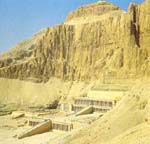 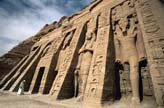
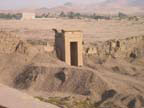 Valley of the
Kings Valley of the
Kings
The Egyptian belief that "To speak
the name of the dead is to make him live again" is certainly
carried out in the building of the tombs. The king's formal names
and titles are inscribed in his tomb along with his images and
statues. Beginning with the 18th Dynasty and ending with the 20th,
the kings abandoned the Memphis area and built their tombs in
Thebes. Also abandoned were the pyramid style tombs. Most of the
tombs were cut into the limestone following a similar pattern:
three corridors, an antechamber and a sunken sarcophagus chamber.
These catacombs were harder to rob and were more easily concealed.
Construction usually lasted six years, beginning with the new
reign. The text in the tombs are from the Book of the Dead, the
Book of the Gates and the Book of the Underworld. See also a
history and overview of the Valley 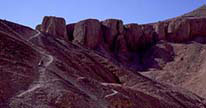 of the Kings. of the Kings.
Tutankhamun
Though small and unimpressive,
Tutankhamun's Tomb is probably the most famous, due to its late
discovery. Howard Carter's description upon opening the tomb in
1922 was, "At first I could see nothing, the hot air escaping from
the chamber causing the candle flames to flicker, but presently, as
my eyes grew accustomed to the light, details of the room within
emerged slowly from the mist, strange animals, statues and gold -
everywhere the glint of gold. For 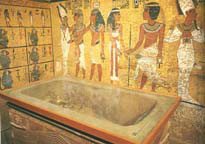 the moment - an eternity it must have seemed to the
others standing by - I was dumb with amazement, and when Lord
Carnarvon, unable to stand the suspense any longer, inquired
anxiously, 'Can you see anything?' it was all I could do to get out
the words, "Yes, wonderful things."' The royal seal on the door was
found intact. The first three chambers were unadorned, with
evidence of early entrance through one of the outside walls. The
next chamber contained most of the funerary objects. The
sarcophagus was four guilded wooden shrines, one inside the other,
within which lay the stone sarcophagus, three mummiform coffins,
the inner one being solid gold, and then the mummy. Haste can be
seen in the reliefs and the sarcophagus, due to the fact that
Tutankhamun died at only 19 years of age following a brief reign.
Though extremely impressive to the modern world, the treasures of
Tutankhamun must have paled when compared to the tombs of the great
Pharaohs that ruled for many years during Egypt's golden
age. the moment - an eternity it must have seemed to the
others standing by - I was dumb with amazement, and when Lord
Carnarvon, unable to stand the suspense any longer, inquired
anxiously, 'Can you see anything?' it was all I could do to get out
the words, "Yes, wonderful things."' The royal seal on the door was
found intact. The first three chambers were unadorned, with
evidence of early entrance through one of the outside walls. The
next chamber contained most of the funerary objects. The
sarcophagus was four guilded wooden shrines, one inside the other,
within which lay the stone sarcophagus, three mummiform coffins,
the inner one being solid gold, and then the mummy. Haste can be
seen in the reliefs and the sarcophagus, due to the fact that
Tutankhamun died at only 19 years of age following a brief reign.
Though extremely impressive to the modern world, the treasures of
Tutankhamun must have paled when compared to the tombs of the great
Pharaohs that ruled for many years during Egypt's golden
age.
Cairo Museum: over 100 rooms containing the
largest collection of Egyptian antiquities in the world. - Two
exhibits worth viewing are the famous King Tutankhamen gallery and
the Akhenaton room. The museum is always crowded so take a deep
breath and enjoy the experience. The bookstore is quite good and
reasonably
priced.
 
The
greatest collection of Egyptian antiquities, which houses over
200,000 ancient Egyptian artifacts, is, without doubt, the Egyptian
Museum in Cairo. It is a place of true discovery and, even after
many visits, you will continue to make new and delightful
discoveries every time you venture into its many
galleries.
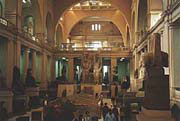 To be sure, the museum can be daunting in the
sheer numbers of its antiquities on show, but there is an order
within its layout and it is a dream come true for anyone wanting to
study Egyptian
antiquities. To be sure, the museum can be daunting in the
sheer numbers of its antiquities on show, but there is an order
within its layout and it is a dream come true for anyone wanting to
study Egyptian
antiquities.
The
museum's ground floor follows the history of ancient Egypt. Upon
entering through the security check in the building, one looks
toward the atrium and the rear of the building with many items on
view - from sarcophagi and boats to enormous
statues.
Just
in front of these you will find an Object of the Month on display.
Behind it are some of the most important items from the time of the
unification of Upper and Lower Egypt some 5,000 years ago,
including the famous slate palette of king Narmer - one of the
first documents of Egyptian history. Also on show are small
masterpieces of sculpture - keep in mind that these are some 50
centuries 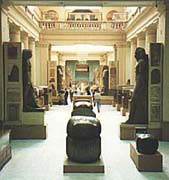 old. This
is an area that should not be
missed! old. This
is an area that should not be
missed!
From
the entrance area itself, turn left and you will find an amazing
diversity of small statues from the Old Kingdom - they depict
individuals, families, and people at
work.
Continuing around the building in a clockwise
direction takes you forward in time as you duck into the different
rooms. At the far end of the building you will be confronted by
material from the time of the heretic pharaoh,
Akhenaten.
Upstairs on the first floor (i.e.second level) are
thousands of smaller items from the span of Egyptian history. Of
course, everybody wants to see the treasures from Tutankhamun's
tomb - these occupy a large area along almost two side of the upper
floor. Chariots, gloves, jewellery, the famous mask - many of the
antiquities from his tomb are displayed
here.
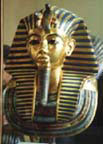 Tutankhamun's tomb contained four gilded shrines
nested one inside the other. All four of these shrines are on
display in the museum. They are lined up in order of decreasing
size. The innermost of these covered a stone sarcophagus which
remains in the tomb. Inside the stone sarcophagus were three
coffins - the innermost being made of 110 kilograms of solid gold.
Inside that lay the pharaoh himself wearing the famous gold mask
(at right). Tutankhamun remains in his tomb to this day. Two of his
three coffins are on display in the same room as the mask, along
with stunning jewellery. This room alone can occupy one for a
considerable time. The room has been remodelled recently with
better
presentation. Tutankhamun's tomb contained four gilded shrines
nested one inside the other. All four of these shrines are on
display in the museum. They are lined up in order of decreasing
size. The innermost of these covered a stone sarcophagus which
remains in the tomb. Inside the stone sarcophagus were three
coffins - the innermost being made of 110 kilograms of solid gold.
Inside that lay the pharaoh himself wearing the famous gold mask
(at right). Tutankhamun remains in his tomb to this day. Two of his
three coffins are on display in the same room as the mask, along
with stunning jewellery. This room alone can occupy one for a
considerable time. The room has been remodelled recently with
better
presentation.
Apart from the Tutankhamun exhibits upstairs, there
are countless coffins, amulets, ushabtis, household items, etc.
Some of the Middle Kingdom tomb models of armies, boats and
landowners surveying their livestock shouldn't be missed. The human
figures almost seem alive! Also upstairs is the Mummy Room where
you can come face to face with some of the great rulers of ancient
Egypt.
Day 8: CAIRO /
HOME
Our final
"Good-bye." Some of our group will be transferring to the airport
today and other will be boarding a bus for our journey to the Sinai
Peninsula.
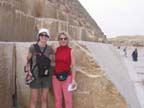 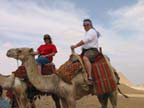 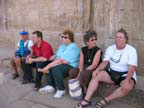
EXTENSION
TOUR
TO SINAI
PENINSULA
Day 1: CAIRO / ST. CATHERINE
(B)
Check out of our
five-star hotel as we say farewell to those heading home today.
Board our air-conditioned bus for our drive to St. Catherine. After
enjoying the countryside and its magic we check into our hotel.
This evening we will climb Mount Sinai for an anchoring ceremony on
this powerful mountain where Moses wrote the Ten Commandments. Once
arriving at the top, you can relax and gaze at the millions of
stars before drifting off to sleep. Overnight Hotel (B)
Day 2: ST. CATHERINE / DAHAB
(B)
We awaken early this morning to watch the sun rise from the top of Mt. Sinai. After this you will begin your descent towards St. Catherine €™s Monastery where you will be able to visit the smallest, yet oldest Christian Monastery in the world. We arrive back in Dahab around noon to enjoy the beach and the inviting Red Sea where the rest of the day and night is free. Overnight Hotel (b)
Day 3: ST. CATHERINE
(B)
This day we will
follow our hearts and our Egyptian Brother Amro Mounier to discover
more wonders of the Sinai Penninsula and complete our ceremonies
and Anchoring. Overnight Hotel. (B)
Day 4: ST. CATHERINE / CAIRO
(B)
Transport to Cairo
airport for your final departure. Home Sweet Home
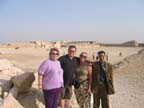 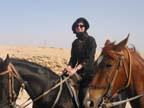
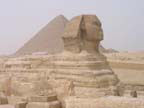 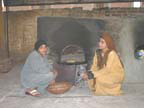 
END OF
TOUR
(Itinerary subject to change if new
opportunities
arise!)
For
more information, CLICK HERE.
To Inquire or Register, CLICK
HERE.
TOUR
FEES:
RIDING THE WAVE
Anchoring the 9th Wave of Unity Consciousness in
Egypt
Shared room
fees, per person:
(includes non-refundable deposit)
Single room
fees, for one person:
(includes non-refundable deposit)
Accommodation in Cairo at Le Meridien Pyramids Hotel or similar.
Accommodation in Aswan at Movenpick Hotel or similar.
Accommodation in Luxor at Steigenberger Nile Palace Hotel or similar.
Accommodation
on board of the sleeper train from Cairo to Aswan.
Domestic flight ticket Luxor -- Cairo.
All transfers
as per the above-mentioned itinerary.
All entrance
fees for the above-mentioned sightseeing.
Meals as
mentioned below (B) Breakfast - (L) Lunch and (D) Dinner.
English
speaking tour guide during sightseeing.
Tour
excludes:
Visa entry to
Egypt.
Tipping.
Any
international flights.
Any personal
expenses such as drinks, laundry, etc.
Any optional
trips or unmentioned items above.
Optional Sinai
Extension
B/L/D -- breakfast-lunch-dinner will be subject to our touring schedule but we will adhere to this schedule as close as possible.
Itinerary
subject to change as situations and guidance
dictate.
Passport required. Visa required for US citizens. No
immunizations
required.
To Inquire, CLICK
HERE.
To Register, CLICK
HERE.
For more information about
this tour, CLICK
HERE.
Take the leap,
follow your heart, experience the
adventure!
To Register, CLICK HERE.
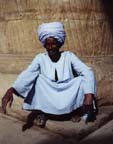 EGYPT "MYSTERY OF THE
SPHINX" EGYPT "MYSTERY OF THE
SPHINX"
11-Day Tour
TOUR ITINERARY
Day
1:
Leave home to
travel to Egypt on night flight.
Day
2:
Arrive at Cairo
International Airport and transfer to 5-star hotel. Dinner at
hotel.
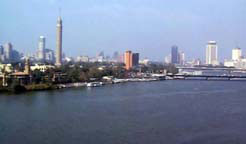
  
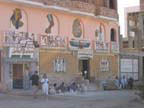 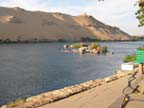
Day
5:
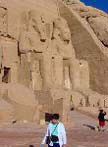 Early morning, view Temples of Abu Simbel as sun
rises over the serene Nile River. Return to ship and sail North.
While cruising, view remains of Kassr Ibrim, sole vestige of the
distant past of Nubia, in its original location from the Pharaonic
period. The Ruins of the arches of a Roman citadel and a cathedral
still dominate the summit above the East Bank. After lunch visit
the Amada Oasis and Temple of Amada. Sail to Wadi el Sebou. Dinner
and overnight on board at Wadi El Sebou. (Breakfast, Lunch, and
Dinner) Early morning, view Temples of Abu Simbel as sun
rises over the serene Nile River. Return to ship and sail North.
While cruising, view remains of Kassr Ibrim, sole vestige of the
distant past of Nubia, in its original location from the Pharaonic
period. The Ruins of the arches of a Roman citadel and a cathedral
still dominate the summit above the East Bank. After lunch visit
the Amada Oasis and Temple of Amada. Sail to Wadi el Sebou. Dinner
and overnight on board at Wadi El Sebou. (Breakfast, Lunch, and
Dinner)
Abu
Simbel
Abu Simbel is a
temple built by Ramesses II (c.1279-1213 B.C.E.) in ancient Nubia,
where he wished to demonstrate his power and his divine nature.
Four colossal (65 feet/20 meters high) statues of him sit in pairs
flanking the 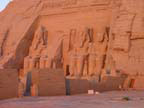 entrance. The head and torso of the statue to the
left of the entrance fell during ancient times, probably the result
of an earthquake. This temple faces the east, and Re-Horakhty, one
manifestation of the sun god, is shown inside the niche directly
above the entrance. The alignment of the temple is such that twice
a year the sun's rays reach into the innermost sanctuary to
illuminate the seated statues of Ptah, Amun-Re, Ramesses II, and
Re- Horakhty. entrance. The head and torso of the statue to the
left of the entrance fell during ancient times, probably the result
of an earthquake. This temple faces the east, and Re-Horakhty, one
manifestation of the sun god, is shown inside the niche directly
above the entrance. The alignment of the temple is such that twice
a year the sun's rays reach into the innermost sanctuary to
illuminate the seated statues of Ptah, Amun-Re, Ramesses II, and
Re- Horakhty.
The temple was cut
out of the sandstone cliffs above the Nile River in an area near
the Second Cataract. When the High Dam was being constructed in the
early 1960s, international cooperation assembled funds and
technical expertise to move this temple to higher ground so that it
would not be inundated by the waters of Lake Nasser.
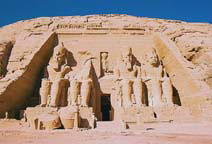 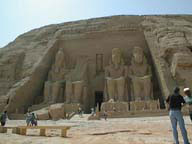
Sunk Relief of
the God Hapy
At Abu Simbel,
below the seat of one of the colossal statues of Ramesses II
(c.1279-1213 B.C.E.), is this sunk relief of the god Hapy, the
personification of the Nile flood. The figure of Hapy appears
twice, tying stems of plants around the hieroglyph for "unite." The
extended foot of each Hapy figure rests on the hieroglyph which is
a lung from which a windpipe projects straight up from the center,
forming a "T" at the top. On the left Hapy holds stems of the lotus
(symbol of Upper Egypt); on the right he holds stems of the papyrus
(Lower Egypt). Hapy's crowns also display these plants. Hapy is
androgynous (both male and female characteristics), suggesting the
fertility of the land which results from the Nile flood. This
androgyny explains his pendant breasts and swollen belly. The
centralized image of the lung and windpipe flanked by the two
figures of Hapy illustrate the Egyptian concern for balance and
order. The cartouche of Ramesses II sits directly above the lung
and windpipe.
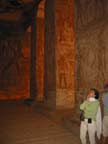 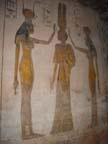 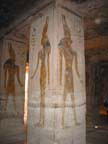 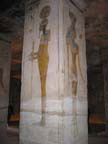
The Temple of
Hathor
The Temple of
Hathor at Abu Simbel was built by Ramesses II (c.1279-1213 B.C.E.)
to honor both Hathor as the goddess of love/music and his wife
Nefertari as the deified queen. The facade, resembling a pylon, has
six standing colossal (over 33 feet/10 meters high) statues. On
each side of the entrance, two statues of Ramesses flank one of
Nefertari dressed as Hathor. The colossal statues are, in turn,
flanked by smaller statues of their children.
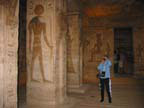 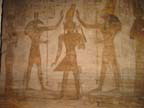 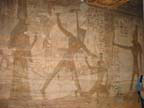
Day
6:
Morning visit to
temple of Wadi El Sebou, a rock temple dedicated by Ramses II to
the two Gods, Amon Ra and Ra Harmakis. Later visit Temple of Dakke,
dedicated to Thoth, God of divine wisdom, Lord of Time and
Sciences, Master of Divine Literature. Visit Roman Temple of
Moharraka. Sail to Aswan. Dinner and overnight on board at Aswan. .
(Breakfast, Lunch, and Dinner)
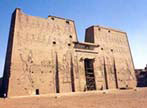
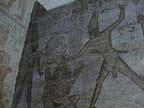

Day
7:
Morning
disembarkation at Aswan and visit Kalabsha Temple with its
Pharaonic aspect, remodeled into Greco roman style, dedicated to
the God Mandoulis, the Hemi-Speos of Beit El Wali, erected by
Ramses II in the beginning of his reign, and the Kiosk of Kertassi,
erected to honor the Goddess Isis. 5PM Transfer to the railway
station to travel to Luxor ( 3 Hours ) Arrive Luxor & transfer
to your Hotel. Dinner at hotel. Overnight in Luxor. (Breakfast and
Dinner)
 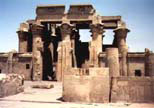
Day 8:
Morning tour to visit West Bank
of Luxor where you will see the Valley of the Kings and Valley of
the Queens, Queen Hatchepsut's Temple at El Deir El Bahari, and
Colossi of Memnon. Return to hotel. Early evening, visit to Luxor
Temple. Dinner at hotel. Overnight in Luxor. (Breakfast and
Dinner)
 

  
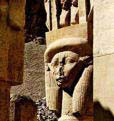 Day 9: Day 9:
Morning drive north
to Quena where you will visit the Temple of Hathour at Denderah.
Subject to government approval, you will visit the Temple of Abydos
or return to Luxor for afternoon at leisure. Dinner at hotel.
Overnight in Luxor. (Breakfast and Dinner)
  
 
Day
10:
Morning visit to
Karnack Temples. Transfer to the railway station to travel back to
Cairo overnight in train (Dinner & breakfast )
 
  
Day
11:
Early morning tour
to visit the Great Pyramids of Giza, including the Kings Chamber,
the Queens Chamber, and the pit. You will also visit the Sphinx
with the Valley Temple. Lunch will be at a typical Egyptian
restaurant in the Sakkara area. Afternoon tour to visit the oldest
of the Pyramids, the step Pyramid of Sakkara, the tomb of King
Zoser of the 3rd Dynasty, built of marble limetsone by the great
architect, Imhotep. (Breakfast and Lunch)
 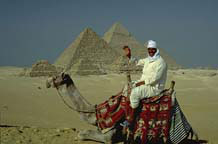
Check out of hotel.
Transfer to Cairo International Airport for return flight to
USA.
For More
Information, CLICK HERE.
SPECIAL BARGAIN
RATES FOR YOUR GROUP:
10 Days in Egypt
with Nile cruise, including international airfare from USA. Price
depends on size of group, travel dates, and origination
city.
For More
Information, CLICK HERE.
Program
includes:
1 night in 5 Stars
Hotel in Cairo half board Dinner & breakfast (either Pyramisa
or Intercontinental Pyramids Park Hotel or Similar)
3 nights in 5 Stars
Deluxe Nile Cruise full board 3 meals per day either Nobian Sea or
Prince Abas or Similar)
3 nights in 5 Stars
Hotel in Luxor half board Dinner & breakfast either Sheraton
Hotel or Isis Hotel or Similar
1st Class Sleeper
train Cairo / Aswan - Luxor / Cairo (Dinner & breakfast
included)
Train Ticket Aswan
/ Luxor
Tour to Abu Simbel
by private AC bus
All entrance fees
to mentioned sights in our program
All transfers from
airport to airport by AC bus
Meet at airport
upon arrival
Multilingual
guides
For More
Information, CLICK HERE.
|
|
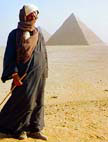
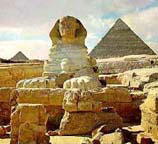





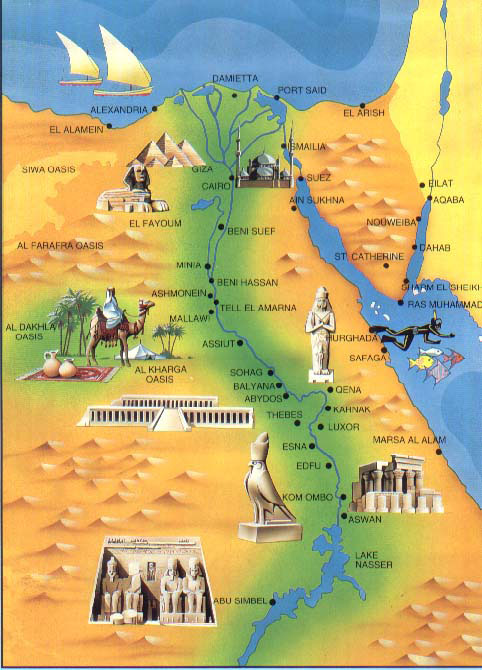
|